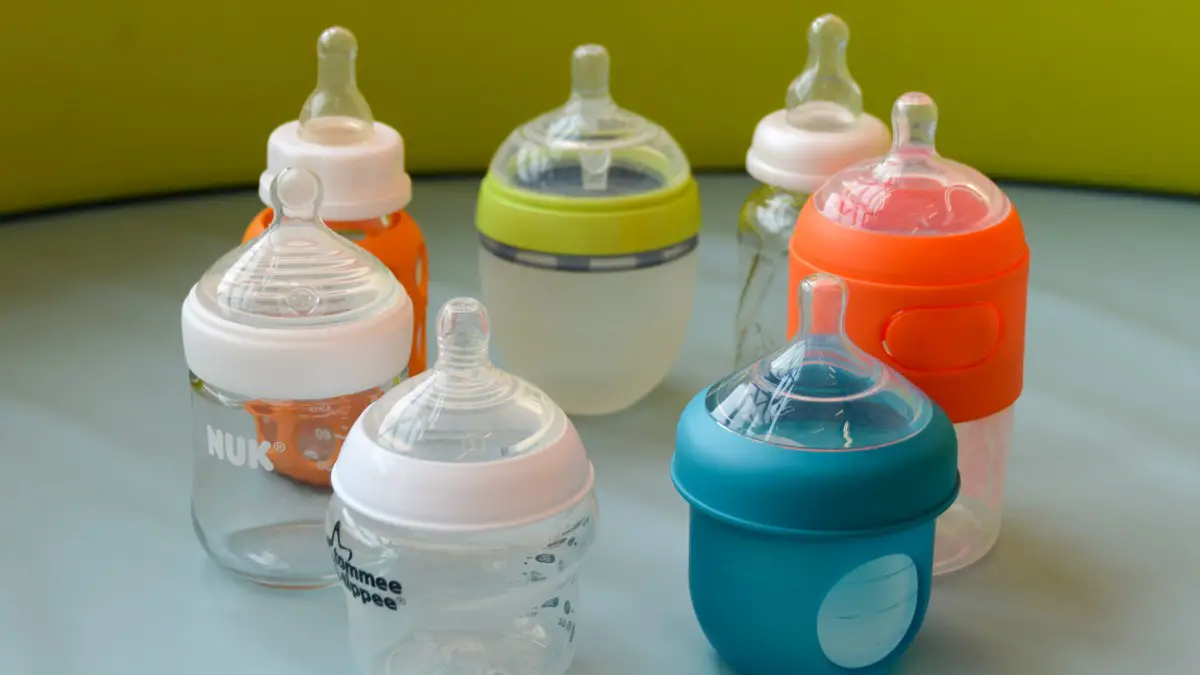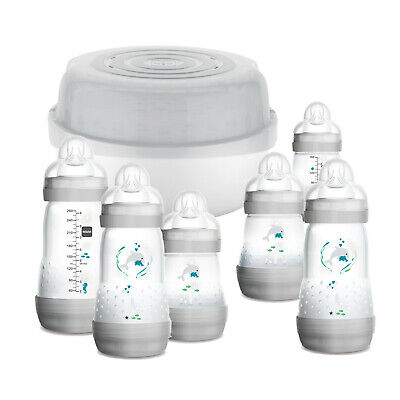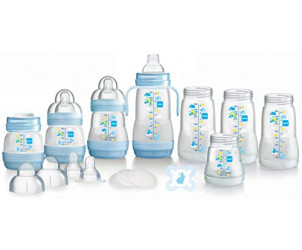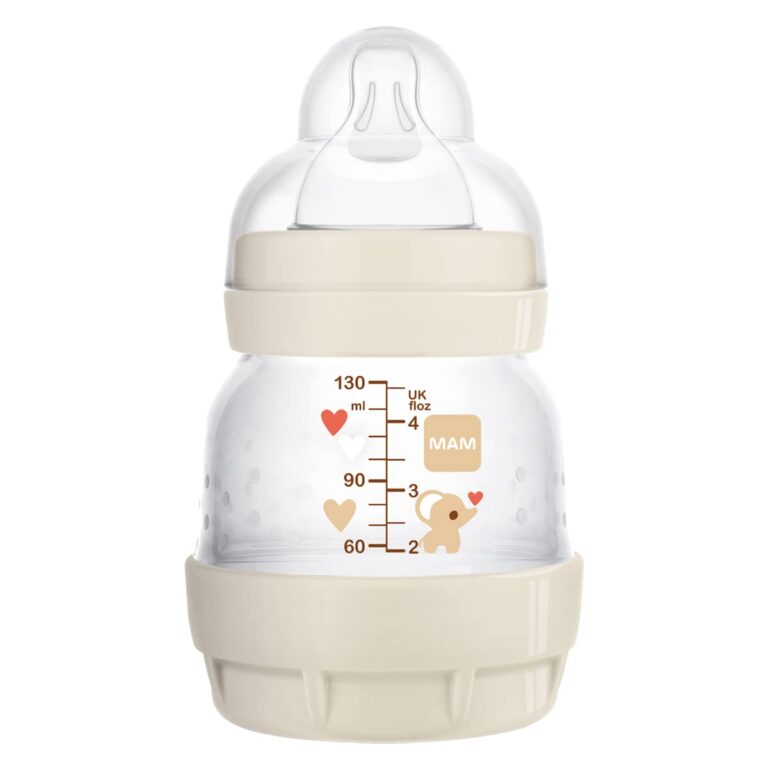Importance of Choosing the Right Nipple Size for Baby Bottles
When it comes to feeding your baby, choosing the right nipple size for their bottle is crucial. The nipple size determines the flow rate of milk or formula, and it can affect your baby’s feeding experience and overall comfort.
Why Nipple Size Matters for Baby’s Feeding
1. Comfort: Babies have different sucking abilities, and using the wrong nipple size can lead to discomfort during feeding. A nipple that is too small can make it difficult for your baby to get enough milk, causing them to suck harder and become frustrated. On the other hand, a nipple that is too large can cause your baby to choke and gag.
2. Pace of Feeding: The flow rate of milk or formula from the bottle’s nipple can greatly impact how quickly your baby consumes their feed. Newborns and younger babies typically require a slower flow rate to prevent overfeeding and digestion issues. As your baby grows and becomes more efficient at feeding, you may need to switch to a faster flow nipple.
3. Development of Oral Skills: Using the right nipple size promotes the development of your baby’s oral skills. Gradually transitioning to a faster flow nipple as your baby grows will help them learn how to coordinate their sucking, swallowing, and breathing. This can support their overall oral motor development.
To help parents select the appropriate nipple size, baby bottle manufacturers often provide nipple size charts that indicate the recommended age range for each size. These charts are a useful reference to ensure your baby is using the right nipple size as they grow.
Here is a general baby bottle nipple size chart:
| Nipple Size | Age Range | Flow Rate |
|---|---|---|
| Slow Flow | 0-3 months | Ideal for newborns |
| Medium Flow | 3-6 months | Suitable for most babies |
| Fast Flow | 6+ months | Suitable for older babies |
It’s important to note that every baby is unique, and there may be variations in their developmental milestones. Some babies may transition to a faster flow nipple earlier or later than others.
Choosing the right nipple size for your baby’s bottle is crucial for their comfort, feeding pace, and overall oral development. It’s recommended to monitor your baby’s feeding cues and consult with their pediatrician if you have any concerns or questions about nipple size selection.
Remember, ensuring your baby’s feeding experience is comfortable and safe is essential for their growth and well-being.
Newborn Nipple Size
Choosing the right nipple size for your baby’s bottle is crucial for their comfort and feeding experience. Newborns have unique feeding needs, and using a nipple that is too fast or too slow can cause difficulties during feeding. Here are some features and benefits of newborn nipples and when to transition to a larger size.
Features and Benefits of Newborn Nipples
Newborn nipples are designed specifically for the first few months of your baby’s life. They have the following features and benefits:
- Slow Flow: Newborn nipples typically have a slow flow rate, mimicking the natural flow of breast milk. This slower flow allows your baby to feed at their own pace and reduces the chances of overfeeding or choking.
- Satisfying Suckling: The texture and shape of newborn nipples resemble the mother’s breast, making it easier for your baby to latch on and experience a more natural suckling motion.
- Reduce Colic and Gas: The slow flow of newborn nipples helps prevent excess air intake, reducing the risk of colic and gas discomfort.
- Easy Transition: If you plan on breastfeeding as well as bottle-feeding, using a newborn nipple can help your baby switch between breast and bottle more smoothly.
When to Transition to a Larger Size
As your baby grows and becomes more skilled at feeding, you may need to transition to a larger nipple size to accommodate their needs. Here are some signs that it may be time to switch to a larger size:
- Increased Feeding Time: If it takes significantly longer for your baby to finish a bottle, it may be an indication that the flow rate is too slow for them.
- Frustration or Agitation: If your baby seems frustrated, agitated, or pulls away from the bottle during feeding, it could be a sign that they are not getting enough milk from the nipple.
- Difficulty with Suckling: If your baby’s sucking becomes more vigorous or they seem to be struggling to get milk from the nipple, it may be a sign that they need a faster flow.
- Age and Development: Every baby is different, but as a general guideline, it is recommended to move to a larger nipple size around three to four months of age or when your baby shows signs of readiness.
Remember, it’s essential to choose the right nipple size based on your baby’s needs and development. Consulting with your pediatrician or lactation consultant can provide further guidance on when to transition to a larger nipple size.
In conclusion, using the appropriate nipple size can greatly affect your baby’s feeding experience and comfort. Newborn nipples are specially designed to meet the needs of newborns, while transitioning to a larger size will ensure your growing baby gets the right amount of milk at a comfortable pace.
Size 0 vs Size 1 Nipples
When it comes to choosing the right baby bottle nipple for your little one, understanding the differences between different sizes can help ensure a comfortable feeding experience. Two common sizes are Size 0 and Size 1 nipples. Let’s explore the differences and learn when it’s appropriate to switch to Size 1 nipples.
Differences between Size 0 and Size 1 Nipples
1. Flow Rate: The main difference between Size 0 and Size 1 nipples lies in the flow rate. Size 0 nipples are typically designed for newborn babies and have a slower flow rate. This slower flow mimics the natural flow of breast milk, promoting comfortable feeding. On the other hand, Size 1 nipples have a faster flow rate, which is more suitable for older babies who can handle a higher milk flow.
2. Nipple Shape: Size 0 and Size 1 nipples may also differ in shape. Size 0 nipples usually have a smaller, rounder shape that is easier for newborns to latch onto. Size 1 nipples may have a wider shape, accommodating a growing baby’s mouth and providing a better seal.
3. Age Recommendation: Size 0 nipples are typically recommended for newborn babies, while Size 1 nipples are suitable for babies around 0-3 months old or when they start showing signs of being unsatisfied with the slow flow of Size 0 nipples.
When and How to Switch to Size 1 Nipples
Knowing when to switch to Size 1 nipples is crucial for your baby’s comfort during feedings. Here are a few signs that your baby may be ready for a faster flow:
1. Restlessness: If your baby seems fussy or impatient during feedings with Size 0 nipples, it may be a sign that they need a faster flow.
2. Increased Feeding Time: If your baby takes longer to finish a bottle than usual or becomes tired during feedings, it could indicate that they need a nipple with a faster flow.
3. Excessive Coughing or Choking: If your baby is struggling to keep up with the flow of milk and frequently coughs or chokes, it may be time to switch to a faster flow nipple.
When switching from Size 0 to Size 1 nipples, it’s important to introduce the new nipple gradually. You can start by offering a bottle with the Size 1 nipple during one feeding per day and observe your baby’s response. If they seem comfortable and able to handle the faster flow, you can gradually transition to using Size 1 nipples for all feedings.
Remember, every baby is different, and their readiness for a faster flow nipple may vary. It’s essential to monitor your baby’s cues and consult with their pediatrician if you have any concerns.
By understanding the differences between Size 0 and Size 1 nipples, as well as knowing when to make the switch, you can ensure that your baby has a comfortable feeding experience that meets their growing needs.
For more information on baby bottle nipples, you can visit Wikipedia’s Baby Bottle page.
Size 2 Nipples
When it comes to feeding your baby, finding the right bottle nipple size is essential for their comfort and development. Size 2 nipples are designed for babies who are around 3 to 6 months old and have different features and benefits compared to smaller nipple sizes.
Features and Benefits of Size 2 Nipples
1. Increased Flow: Size 2 nipples have a larger hole compared to size 1 nipples, allowing for a faster flow of milk or formula. This is beneficial for older babies who have a stronger sucking reflex and can handle a higher flow rate during feeding.
2. Mimics Natural Feeding: The design of size 2 nipples is closer to the shape and size of a mother’s nipple, making it easier for babies to transition between breast and bottle feeding. This can help prevent nipple confusion and ensure a smooth feeding experience for both mom and baby.
3. Minimizes Feeding Time: The faster flow of size 2 nipples reduces the duration of feeding sessions, saving time and energy for both parents and babies. This can be particularly helpful as your baby grows and becomes more efficient at feeding.
4. Reduces Gas and Fussiness: Slow-flow nipples can sometimes cause babies to gulp air, leading to gas and discomfort. Size 2 nipples alleviate this issue by providing a faster flow, allowing for a more controlled and efficient feeding process.
Signs that Baby is ready for Size 2 Nipples
Knowing when to transition to a larger bottle nipple size can be challenging. Here are some signs that your baby may be ready for size 2 nipples:
1. Frustration during Feeding: If you notice that your baby is becoming frustrated or agitated during feedings and is frequently pulling away from the bottle, it may be a sign that the current nipple size is too slow for them.
2. Increased Sucking Strength: As your baby grows, their sucking strength will naturally improve. If you find that your baby is sucking vigorously and emptying the bottle quickly with the current nipple size, it may be time to move up to a larger size.
3. Difficulty with Sleep: If your baby is experiencing frequent night awakenings or increased fussiness after feeds, it could be a sign that they are not getting enough milk during their feeding sessions. Moving up to a larger nipple size can help facilitate a more satisfying feeding experience for your little one.
Remember, every baby is unique, and these signs may vary from child to child. It’s essential to observe your baby’s feeding patterns and consult with your pediatrician if you’re unsure about transitioning to a larger nipple size.
Finding the right bottle nipple size is crucial for your baby’s comfort and feeding experience. By understanding the features and benefits of size 2 nipples and recognizing the signs that your baby is ready for them, you can ensure a smooth and enjoyable feeding journey for both of you.
Size 3 Nipples
When it comes to feeding your baby, choosing the right bottle nipple size is essential for their comfort and development. As your baby grows, their feeding needs change, and it’s important to transition to an appropriate nipple size. Size 3 nipples are designed for babies who are around 6 months old and up, and they offer several features and benefits that cater to their developing needs.
Features and Benefits of Size 3 Nipples
1. Faster Flow: Size 3 nipples have a larger opening compared to smaller sizes, allowing for a faster flow of milk. This is beneficial for older babies who have a stronger suckling reflex and can handle a more substantial volume of milk. It ensures a more efficient feeding experience and prevents your baby from getting frustrated while drinking.
2. Mimics Breastfeeding: Size 3 nipples are designed to simulate the flow rate of breast milk. This helps babies who are transitioning from breastfeeding to bottle feeding to easily adapt and experience a more natural feeding experience.
3. Reduced Colic and Spit-Up: Many size 3 nipples feature an anti-colic design that helps reduce the amount of air your baby ingests during feeding. This can help minimize symptoms of colic and reduce the chances of spit-up, making feeding time more comfortable for your little one.
Signs that Baby is ready for Size 3 Nipples
While every baby is different, there are a few signs that can indicate your little one is ready to move up to size 3 nipples:
1. Increased Fussiness: If your baby seems to be fussier during feeding sessions or shows signs of frustration, it could be a sign that the flow of their current nipple is too slow for their needs.
2. Difficulty with Suction: If your baby seems to be working harder to extract milk from the bottle, it might be time to switch to a faster flow nipple. Struggling to maintain suction can be tiring for your baby and may result in them not getting enough nutrition.
3. Rapid Feeding: If your baby finishes a bottle too quickly, it could be an indication that the nipple flow is too slow for them. Size 3 nipples offer a faster flow to accommodate their growing appetite and ensure they get the nutrition they need.
It’s important to remember that every baby is unique, and it’s essential to monitor their feeding behaviors and adjust the nipple size accordingly. Always consult with your pediatrician or healthcare provider if you have any concerns or questions about your baby’s feeding habits.
In conclusion, transitioning to size 3 nipples is an important milestone in your baby’s feeding journey. These nipples offer a faster flow and several benefits designed to cater to your baby’s changing needs. Pay attention to the signs that indicate your baby is ready for a nipple size upgrade, and always choose nipples that align with their age and development stage.
Variable Flow Nipples
When and How to Introduce Variable Flow Nipples
1. When to Introduce Variable Flow Nipples: Variable flow nipples are designed for babies who are transitioning from slower flow nipples and are ready for a faster milk flow. This typically happens around 3-6 months of age when babies have better control over their sucking and swallowing reflexes.
2. How to Introduce Variable Flow Nipples: When introducing variable flow nipples, it’s important to observe your baby’s feeding cues. If your baby seems frustrated or impatient during feedings with slower flow nipples, it may be a good time to switch to a variable flow nipple. Start by offering the variable flow nipple during one or two feedings per day and gradually increase the frequency as your baby adjusts to the faster flow.
Benefits and Considerations of Variable Flow Nipples
1. Benefits of Variable Flow Nipples: Variable flow nipples provide several benefits for both babies and parents. They allow babies to control the pace of their feedings, which can help reduce the risk of overfeeding and promote healthier digestion. Faster milk flow can also be helpful for babies who have a strong sucking reflex or who are bottle-feeding in combination with breastfeeding.
2. Considerations of Variable Flow Nipples: While variable flow nipples offer benefits, it’s important to consider your baby’s individual feeding needs. Some babies may not be ready for a faster flow and may become overwhelmed or have difficulty coordinating their sucking and swallowing. It’s essential to observe your baby’s feeding behavior and consult with a healthcare professional if you have any concerns.
Here’s a table highlighting the different nipple sizes available for baby bottles:
| Nipple Size | Age Range | Flow Rate |
|---|---|---|
| Slow Flow | 0-3 months | Slow |
| Medium Flow | 3-6 months | Medium |
| Variable Flow | 6+ months | Adjustable |
It’s important to note that every baby is different, and their feeding needs may vary. It’s recommended to consult with a pediatrician or lactation consultant for personalized guidance on choosing the right nipple size for your baby.
In conclusion, variable flow nipples are designed to support babies as they transition to a faster milk flow. By observing your baby’s feeding cues and adjusting the nipple size accordingly, you can provide a comfortable and appropriate feeding experience. Remember to consider your baby’s individual needs and consult with healthcare professionals for personalized guidance.
Tips for Selecting the Right Nipple Size
When it comes to feeding your baby, choosing the right nipple size is important for their comfort and proper feeding. Here are some factors to consider when selecting the nipple size for your baby’s bottle.
Factors to consider when choosing nipple size:
1. Age and Development: Nipple sizes are typically categorized by age groups. Newborn nipples are designed for infants up to three months old, while size 1 nipples are suitable for babies from three to six months. As your baby grows, you may need to transition to a larger size to accommodate their feeding needs.
2. Flow Rate: Nipple sizes also determine the flow rate of the milk or formula. Newborn nipples usually have a slower flow rate, mimicking the pace of breastfeeding. As your baby becomes more efficient at feeding, you may need to switch to a faster flow nipple to meet their growing needs.
3. Baby’s Feeding Style: Every baby has a unique feeding style. Some may prefer a slower flow to prevent overfeeding or swallowing air, while others may require a faster flow to satisfy their hunger. Observe your baby’s feeding patterns and choose a nipple size that matches their pace and comfort level.
4. Bottle Type: Nipple sizes may vary depending on the brand and type of bottle you are using. It’s crucial to choose a nipple that is compatible with your baby’s bottle to ensure a secure fit and prevent leakage.
Common Pitfalls to Avoid:
1. Using the Wrong Size: Using a nipple size that is too small or too large can lead to feeding difficulties for your baby. It’s essential to select the appropriate size based on their age, developmental stage, and feeding style.
2. Ignoring Your Baby’s Cues: Your baby’s cues and comfort should guide your nipple size selection. Be attentive to signs of frustration, excessive leakage, or inadequate feeding, as these may indicate that the nipple size needs adjustment.
3. Not Checking for Wear and Tear: Regularly inspect the nipples for any signs of wear and tear, such as cracks or stretching. Damaged nipples should be replaced promptly to ensure your baby’s safety and optimal feeding.
Remember that every baby is unique, and their feeding needs may change over time. It’s important to monitor their progress and make adjustments to the nipple size as necessary. If you have any concerns or questions, consider consulting with a pediatrician or lactation consultant for guidance.
Using this guidance, you can select the right nipple size for your baby to ensure a comfortable and satisfying feeding experience.
**For more information on choosing the right nipple size for your baby, you can visit [this Wikipedia page](https://en.wikipedia.org/wiki/Baby_bottle#Nipple
Conclusion
Importance of Tailoring Nipple Size to Baby’s Needs
In conclusion, choosing the right nipple size for your baby’s bottle is essential for their comfort and feeding experience. Babies have different sucking abilities and preferences, so it is crucial to tailor the nipple size to their needs. Using an incorrect nipple size can lead to feeding difficulties, such as choking or excessive gas. It’s always best to consult with your pediatrician or lactation consultant for guidance on the appropriate nipple size for your baby.
Choosing the Right Nipple Size for a Positive Feeding Experience
When selecting a nipple size, it’s important to consider your baby’s age and developmental stage. Manufacturers often provide guidelines on the packaging based on age, but it’s essential to remember that every baby is unique. Some babies may prefer a slower flow rate, while others may require a faster flow rate to satisfy their hunger. It may involve some trial and error to find the ideal nipple size that allows your baby to feed comfortably and efficiently.
To help visually understand the variations in nipple sizes, refer to the baby bottle nipple sizes chart below:
| Nipple Size | Age Range | Flow |
|---|---|---|
| Slow flow | Newborn | Ideal for breastfed babies or those with a slower feeding pace. |
| Medium flow | 3-6 months | Suitable for babies who have mastered the sucking reflex and can handle a bit faster flow. |
| Fast flow | 6+ months | Intended for older babies who can handle a quicker flow rate. |
| Variable flow | 6+ months | Allows for adjustable flow based on baby’s sucking strength. |
| Y-Cut | 9+ months | Designed for thick liquids and older babies with stronger sucking abilities. |
Remember to check the nipple regularly for any signs of wear and tear, and replace it if necessary. Additionally, always sterilize the nipples before each use to ensure your baby’s safety and hygiene.
By selecting the correct nipple size, you can ensure your baby has a positive feeding experience while promoting their development and comfort.
References:




